Module 13: Non Timber Forest Products: Growing Opportunities
Lesson One - Introduction: What Are NTFP'S
LESSON ONE - INTRODUCTION: WHAT ARE NTFP'S?
 |
|
Artists conk
|
 |
|
Ash Basket
|
The forests of Nova Scotia have been managed for resources for many years. Historically, most of the products harvested from our forests were logs and pulpwood, which have been extensively inventoried and researched. Wildlife, too, has been a harvested forest resource .
Increasingly however, forests are being considered useful for more than timber products. Clean air and water, crucial for our planet's health, originate in forests. Forests are also important sources of biodiversity and support populations of plants, birds, mammals, reptiles, amphibians, fungi, lichens, bacteria and other forms of life.
 |
|
Getting away from it all
|
Forests have aesthetic and spiritual values, too. Many people use forests for recreation and for "getting away from it all."
Approximately 50 percent of the forested land area in Nova Scotia is owned by small private woodlot owners. Together, they contribute nearly 65 percent of the provincial wood supply to the forest industry each year. Clearly, private woodlots are important for the timber they produce. But what about the other values? Is there any potential for adding value to your woodlot with non timber forest products?
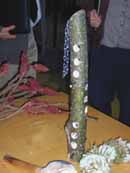 |
|
Striped maple suet birdfeeder
|
WHAT ARE NON TIMBER FOREST PRODUCTS (NTFPS)?
The next time you stroll through your woodlot, keep your eyes open for the small details that many people miss. A few mushrooms here, a clump of red-berried shrubs there. Perhaps a red maple stump sprouting a dozen thumb-size stems, or cones littering the base of a majestic white pine tree. A ruffed grouse drumming in the distance. Wildflowers sprinkled at your feet.
What do you think of when non timber forest products (NTFPs) are mentioned? Berries? Mushrooms? Medicinal plants? Walking sticks? The peace and tranquility of the forest?
 |
|
Tri-spray on brick
|
If you said that all these things are non timber forest products, you'd be right! They are all around you as you stroll through your woodlot. They are found in trees, shrubs, small plants, on the ground and in the soil. And for enterprising woodlot owners, they can be worth money.
A commonly accepted definition of non timber forest products is any goods derived from forest plants or animals, other than timber or firewood. This definition encompasses a great number of possible products!
The list of NTFPs that are present in Nova Scotia's woodlands is a long one. However, NTFPs are often overlooked by woodlot owners, sometimes because they do not know what they have or what to look for. For the most part, woodlot owners usually think only of traditional wood products such as sawlogs, studwood, pulpwood and fuelwood.
 |
|
Pinecone Wreath
|
Commercial forest products are worth an estimated $1.2 billion each year to the economy of Nova Scotia. Our forest industry is built around sawmills, pulp mills, fuelwood sales and forest management activities such as silviculture. Many people are surprised to learn the revenue generated by Nova Scotia's forest industry is very close to that of the tourism industry.
Attend any on of dozens of community markets across the province however, and you'll find that the forest has much more to offer than traditional timber products. You may see folks selling wreaths made from twigs and vines, vendors featuring containers of maple or birch syrup, and gourmet food dealers offering golden chanterelle mushrooms. Other booths
 |
|
Wood Duck
|
may display elaborately carved walking sticks, polished birdseye maple bowls, or blueberry products. You'll soon realize that the nature of forest products is limited only by the imagination!
In the big picture of the forest industry, however, NTFPs are nearly invisible. There is very little data available on the value of the NTFP industry in Nova Scotia. Even though they do not generate nearly the revenue of the commercial forest industry, the value of NTFPs can be significant on a local scale. At a time when the forest industry in Canada is changing due to unpredictable global markets, fluctuating dollar values and imported timber products, NTFPs are becoming increasingly important.
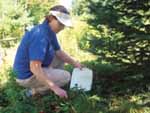 |
|
Collecting bunchberries
|
Besides their economic importance, NTFPs hold important cultural and social values. For example, First Nations peoples in Nova Scotia have been living in harmony with the land for thousands of years. With knowledge accumulated over many generations, the Mik'maq have been using forest materials for food, medicine, shelter and ceremony. Traditionally, everything that the Mik'maq required for living came from the land and water.
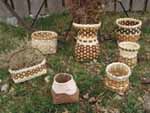 |
|
Baskets
|
In communities across the province, maple and blueberry festivals provide important social occasions. They bring local people together to work and interact with one another, while attracting folks "from away" to experience the flavour of the local culture. In some areas, such as the St. Mary's River where the heritage of the river is cherished, fishing for Atlantic salmon attracts a large number of anglers each year. This activity is very important to the local economy of towns such as Sherbrooke, and further highlights the diversity of non timber products.
For many people, a stroll in the woods can be a spiritual experience. Picture this: you walk over moss-carpeted forest floor, occasionally stepping on crunching leaves and twigs, the cool fresh air filling your lungs. The sun is gently filtered by the rich green canopy above, muting colours and shadows, painting small openings with golden light. An insect buzzes your ear and you swat it, only to realize that a barred owl is watching you from a nearby maple tree. The owl spreads its wings and glides silently away into the forest. It is a relaxing, revitalizing experience.
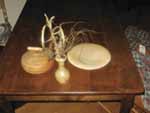 |
|
Wooden crafts & products
|
Can you put a price on this kind of encounter with nature? Is it considered a product? For many eco-tourism and adventure outfitters, it is. Their businesses are built around the unique, wild and unspoiled images that Nova Scotia offers.
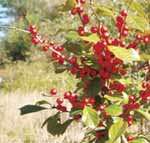 |
|
Canada holly
|
Are there some special areas of your woodlot to which you can retreat, where the cares of the world slip from your shoulders? Does there seem to be a design in the elements around you? Do you see more than wood products when you look at your woodlot?
